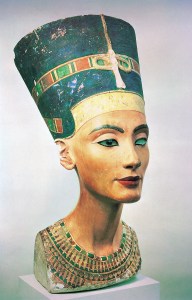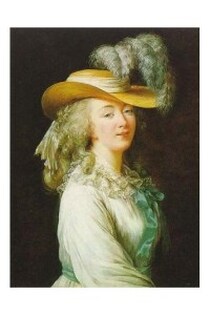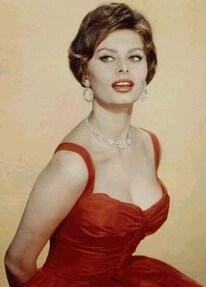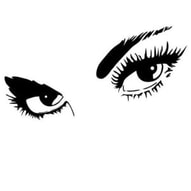A History of Eyebrow Shaping

According to the documentation of the Greek historian Herodotus (484-425 B.C.), the ancient Egyptians would shave their eyebrows in mourning whenever one of the cats in their home died. (And everyone in the home would shave their whole body if their dog died – but that is perhaps saved for another day in an article about waxing!).
When they were not respecting the passing of a cat, however, the Egyptians were known to take an interest in the shape and color of their eyebrows, sporting an arched eyebrow that was darkened with a powder made from Galena, a lead-based mineral (as well as “Kohl”, a mineral composition first used around 3000 B.C. and through the nineteenth century for both brows and eyelids).
Bring in The Goats
Animals somehow figure into the eyebrow fashions of both the ancient Greeks and Romans too. Poets and writers of the time referenced women wearing false brows made from goat hair and attached with tree resin! Kohl was still the preferred mineral powder of choice to darken brows. However, along with the goat hair, there was not a lot to envy about ancient eyebrows of the time because all of this effort was made to perfect the unibrow, the preferred look at the time.
Last Word on the Unibrow
While we have grown up with a disdain for the unibrow, it apparently took thousands of years for us to come to our senses. As it turns out, the Greeks and Romans influenced the world well beyond the arts, literature and philosophy. Women of the Byzantine Empire (285-1461), the Qatar Dynasty of Iran (1785-1925) and others all admired and cultivated their own unibrows.
Meanwhile, In Middle Age Europe…

With Medieval women looking to attract attention to their domed foreheads (the desired look at the time), eyebrow plucking finally became a thing (in what must have been a big relief to women who were not interested in a unibrow!). Pencil-thin brows also got lighter, as strawberry-blonde became the standard perhaps out of deference to Queen Elizabeth I of England.
When Less is More…Way Less.
In both Europe and Japan, removing the eyebrow entirely was considered beautiful, and it had nothing to do with an expiring housecat. 17th century Europeans would remove the brow entirely and rub walnut oil into it to prohibit them from growing back while the Japanese removed them because they preferred what they could do with pencil – redrawing them higher on the forehead in a hazier, cloud-like style.
Can We Stop Using Animals Now?

In Europe, sticking with one look was hard to do century-to-century (though we now rarely find ourselves with the same style year to year!). After turning away from the unibrow and going with the pencil-thin brows, lightening them, and then removing them altogether, they decided they wanted something bushy, but not quite a unibrow. However, women who used to use walnut oil to prevent their brows from growing now found themselves falling behind trends. Enter the “mouse fur eyebrow wig”. Yes, when it was time for bold brows to make a comeback (and it wouldn’t be the last time!), it was the mouse that stepped up and made the difference. False eyebrows were made from furry mouse skin pieces, and attached higher up on the forehead to create a “quizzical” look. It is possible that many of the 17th and 18th century European paintings you see in your museum are showing women wearing a bit of mouse fur above their eyes!
The Fast-Moving Brows of the Twentieth Century and Beyond
The 20’s – Pencil thin brows came back in the Roaring 20’s, a time when American women used beauty as part of the move to liberate themselves. Modeled after silent film start Clara Bow, brows slanted slightly downward and went beyond the edge of the eye.
 The 30’s – Brows remained thin, shortened a bit and shaped to look stronger, with a higher arch. Greta Garbo and Jean Harlow were models for the more pronounced, curvature arches that presented a more dramatic look.
The 30’s – Brows remained thin, shortened a bit and shaped to look stronger, with a higher arch. Greta Garbo and Jean Harlow were models for the more pronounced, curvature arches that presented a more dramatic look.
The 40’s – Brows get a little less severe, thicker and softer looking. Think Lauren Bacall and Grace Kelly.
The 50’s – Elizabeth Taylor, Marilyn Monroe and Audrey Hepburn all sported the “New Look” create by Dior that called for a full face of make-up where the brow was lush, strong and high-arched.
 The 60’s – An era where women didn’t really mess with their brows – shaving them off completely and then penciling them back in with short, thin strokes to create a look that APPEARED natural. While most people did not notice her brows, this was a signature look for Sophia Loren.
The 60’s – An era where women didn’t really mess with their brows – shaving them off completely and then penciling them back in with short, thin strokes to create a look that APPEARED natural. While most people did not notice her brows, this was a signature look for Sophia Loren.
The 70’s – If you are one how is cool with letting your brows run wild, then you might be a child of the 70’s! The hippie movement brought back the natural brow, with less plucking and a natural shape.
The 80’s – Using “Eyebrow” in the context of the 80’s automatically infers the name “Brooke Shields”. Think “bushy” the way you imagined those “mouse fur eyebrow wigs” from the 17th century!
The 90’s – Lots of tweezing in this decade, but eyebrows kind of went all different ways. Drew Barrymore and Pamela Anderson went for the “overplucked” look while others retained their 80’s “bushiness” and still others shaved them completely.
Today and beyond – Today it is all about the “Power Brow”, with many tweezers collecting dust at home. Bold, big and dark, the thicker the better…for now! Some experts see the Brooke Shields look coming back around the corner, but don’t lose your tweezers either – they will also get their turn again as well!
Getting Your Own Brows Right:
As a Aveda Professional Salon and Spa, Studio 16 won’t put mouse fur on your eyebrows, nor do we use or sell any other animal-based or animal-tested products. For a beautiful updated look to your own brows, call today or click here for an appointment at our Brow Bar to go with one of your other regular services.

This article was researched and written by special guest contributor, David Dallaire.




 The 30’s – Brows remained thin, shortened a bit and shaped to look stronger, with a higher arch. Greta Garbo and Jean Harlow were models for the more pronounced, curvature arches that presented a more dramatic look.
The 30’s – Brows remained thin, shortened a bit and shaped to look stronger, with a higher arch. Greta Garbo and Jean Harlow were models for the more pronounced, curvature arches that presented a more dramatic look. The 60’s – An era where women didn’t really mess with their brows – shaving them off completely and then penciling them back in with short, thin strokes to create a look that APPEARED natural. While most people did not notice her brows, this was a signature look for Sophia Loren.
The 60’s – An era where women didn’t really mess with their brows – shaving them off completely and then penciling them back in with short, thin strokes to create a look that APPEARED natural. While most people did not notice her brows, this was a signature look for Sophia Loren.

Leave your thought here
Your email address will not be published. Required fields are marked *